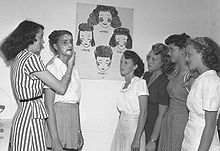Friday, September 30, 2011
Costume designer
Costume designer Robert Edmond Jones
(1887-1954) drawing at a waist high table (c. 1920).
.
Costume designers will typically
seek to enhance a character's personality, and/or to create an evolving plot of
colour, changing social status or period through the visual design of garments
and other means of dressing, distorting and enhancing the body - within the
framework of the director's vision. At the same time, the designer must ensure
that the designs allow the actor to move in a manner consistent with the
historical period and enables the actor to execute the director's blocking of
the production without damage to the garments. Additional considerations
include the durability and washability of garments, particularly in extended
runs. The designer must work in consultation with not only the director, but
the set and lighting designers to ensure that the overall design of the
production works together. The designer needs to possess strong artistic
capabilities as well as a thorough knowledge of pattern development, draping,
drafting, textiles and costume/fashion history as well as awareness of poise
when in period dress, and be sensitive to the creative direction that the
performer wants to take his/her character
.
.
Information on Cosmetology
Information on Cosmetology
Cosmetology! The term does not sound new. The beauty consciousness is not in consideration in day-to -day’s life but it is in mind of people right from past many years and civilizations. The keen interest of people in beauty had generated a branch and that is termed as Cosmetology. The field of Cosmetology is very vast and one can become skin care specialist, hairstylist, hair dresser, and shampooer & nail technician. Just because of awareness of both men and women towards their beauty lead to increase the scope and ambit of Cosmetology. This business could never tastes the failure as the person will never leave to see in the mirror! Thus, career in Cosmetology is prolific one. To get perfection and fruitful outcome in this field, the only point you must keep in mind is that go for best school for gaining education and training through superlative school only.
If you just take Cosmetology degrees and certifications programs, then you are capable enough for attaining proficiency for personal use, but if you are willing to make Cosmetology as your profession, then you must have to take admission in certain affiliated institutes for gaining training in the field. To make a career in any of the area of Cosmetology, one should join the Cosmetology school. United States hold the topmost position in imparting education and training in General Cosmetology.
The basic requirement of getting education in Cosmetology is that the age of the willing person should be not less than 16 years. When a person decides for practicing Cosmetology, then he should have completed Graduation in General Cosmetology. But only gaining education in particular field is not enough to get a start, license in that field of Cosmetology is needed
Thursday, September 29, 2011
Cosmetology
Ndividual disciplines within cosmetology
Shampoo
technician
A shampoo
technician shampoos and conditions a client's hair in preparation
Manicure
A manicure
is a cosmetic treatment for the fingernails or hands. The word
"manicure" derives from Latin: Manus for hand, cura for
"care." When performed on the feet, such a treatment is a pedicure.
Many
manicures start by soaking the hands in a softening substance, followed by the
application of lotion. A common type of manicure involves shaping the nails and
applying nail polish. A manicure may also include the application of artificial
nail tips, acrylics, or artificial nail gels. Some manicures can include the
painting of pictures or designs on the nails, or applying small decals or
imitation jewels. Manicurists usually take special cosmetology courses.
Aesthetician
Aestheticians
work at salons and day spas. Aestheticians specialize in beautifying the skin.
They perform cosmetic skin treatments including hair removal (waxing,
threading), massage, body wraps, skin care, eyelash and eyebrow tinting,
eyelash extensions, aromatherapy, permanent make up, and make-up application.
Aestheticians may also specialize with machine treatments such as non surgical
"face lifts" and faradic muscle tone. The specialist may undergo
special training for treatments such as laser hair removal and electrolysis.
Aestheticians must be licensed in the state they are working in. In order to
become one they must complete 260 to 900 hours of training and pass both a
written and hands-on exam. Aestheticians usually work under a dermatologist’s
supervision and usually treat mild cases of acne.
Nail
technician
A nail technician
specializes in the art form and care of nails. This includes manicures,
pedicures, acrylic nails, gel nails, nail wraps, fake nails, self adhesive nail
coverings, etc. Although they are generally trained to recognize diseases of
the skin and nail,[2] they do not treat diseases and would typically refer a
client to a physician.
Electrologist
An
electrologist offers services with the use of a machine. As opposed to the hair
removal via waxing offered by an esthetician, hair removal via electrolysis is
permanent. Usually estheticians will seek higher education beyond beauty school
to learn electrolysis. Some state board beauty schools, however, teach
electrolysis in basic courses.
Hair
Stylist
A hair
stylist is someone who cuts and styles hair. He or she can also offer other
services such as coloring, extensions and straightening. A good hairstylist has
a sense of fashion and the ability to know what style will look the best on a
client. Hair stylists often do hair for weddings, proms, and other special
events in addition to routine hairstyling.
Hair
Colorist
A colorist
is a hair stylist that specializes in coloring hair. In the US, some colorists
are “board certified” through the American Board of Certified Haircolorists.
This designation is used to recognize colorists that have a greater level of
competency in the industry
.
Becoming
A Cosmetologist

General
cosmetology courses in the United States focus primarily on hairstyling, but
also train their students as general beauticians versed in manicures, facials,
etc. In a state-licensed beauty school, a certificate course in general
cosmetology typically takes approximately one year to complete. Specialized,
non-hairstyling courses such as manicure, facials, or makeup art are usually of
shorter duration, lasting anywhere from two weeks to six months, although the
most prestigious and exclusive beauty schools may offer much longer courses. In
Higher Learning Institutions, an Associate's Degree can be awarded on the path
to becoming a cosmetologist.
In the
United States, all states require barbers, cosmetologists, and most other
personal appearance workers (with the exception of shampooers in very few
states, not including CA) to be licensed; however, qualifications for a license
vary by state. Licensing for those working with the Military, deceased, and
handicapped may vary depending on the state [3] . Generally, a person must have
graduated from a state-licensed barber or cosmetology school and be at least 17
years old. A few states require applicants to pass a physical examination. Some
states require graduation from high school, while others require as little as
an eighth-grade education. In a few states, the completion of an apprenticeship
can substitute for graduation from a school, and for many students an
apprenticeship in cosmetology is the most expansive way to obtain a hands on
education in their respective fields. Applicants for a license usually are
required to pass a written test and demonstrate an ability to perform basic
barbering or cosmetology services.
In most
states, there is a legal distinction between barbers and cosmetologists, with
different licensing requirements.[5] These distinctions and requirements vary
from state to state. In most states, cosmetology sanitation practices and
ethical practices are governed by the state's health department and a Board of
Cosmetology. These entities ensure public safety by regulating sanitation
products and practices and licensing requirements. Consumer complaints are
usually directed to these offices and investigated from there.
Persons
interested in practicing cosmetology can graduate from a general cosmetology
course and then obtain a license in any of the cosmetology sub-disciplines, or
they can choose to study only to become a manicurist or esthetician. Students
may choose a private beauty school or one of the many vocational schools which
offer cosmetology courses to high school students. In addition, there are
national organizations that provide educational and professional information.
Income
Median hourly
wages in May 2008 for hairdressers, hairstylists, and cosmetologists, including
tips and commission, were $11.13. The middle 50 percent earned between $8.57
and $15.03. The lowest 10 percent earned less than $7.47, and the highest 10
percent earned more than $20.41 according to the United States Department of
Labor. Much of this depends on whether the cosmetologist is paid hourly,
salary, contract or commission, and whether they rent a booth and have
increased overhead expenditures. The cosmetologist's wages may also depend on
the ability of the cosmetology professional to market themselves, upsell
products and services, and expand clientele and improve client loyalty. Other
factors include the size and location of the salon or beauty business, how many
hours worked, local tipping habits, and competition from other beauty
businesses. The 2003 NACCAS Job Demand Survey suggests that there is a shortage
of salon professionals in the working world, so cosmetologists and salon
professionals have increased earning power. The salon industry has little to no
unemployment.[6]
Cosmetologists
are paid in a variety of ways:
Hourly or
Commission: Cosmetologist are paid a commission percentage, subject to a
guaranteed minimum hourly wage and, and at the end of a pay period, they are
paid whichever is the greater of the two. This system is set up to comply with
state and federal minimum wage laws.
Hourly plus
Commission: In addition to an hourly wage, a percentage of the money made from
the provision of services is given back to the cosmetologist as income.
Sometimes the percentage is a set amount, and sometimes the cosmetologist must
reach a certain goal before the commission is paid.
Booth
Rental: All of the revenue derived from services provided is paid to the cosmetologist
performing said services. In this arrangement, the cosmetologist is an
independent contractor and pays a rental fee or a "chair fee" for the
usage of salon facilities. Typically the cosmetologist has to provide all of
their own supplies and book their own appointments.
Hourly:
Strictly hourly wage; most of the time cosmetologists keep their own client
tips, but sometime client tips are pooled and distributed evenly amongst all
beauty professionals working in the salon (tip pools are illegal in many
states). Many corporate and small chains are trending toward this compensation
structure, for it promotes a more controlled product by ensuring that employees
are responsible for following company standards and policies.
Tips:
Cosmetologists often make a considerable portion of their income from client
tips
Product
Sales: Usually a commission is given on retail products sold, regardless of
compensatory structure.
Occupational
Hazards
Many
chemicals in salon products pose potential health risks, the majority of which
are not well regulated. Examples of hazardous chemicals found in common
treatments (i.e. hair coloring, straightening, perms, relaxers, Keratin
treatments, Brazilian Blowouts and nail treatments) include dibutyl phthalate,
formaldehyde, lye (sodium hydroxide), ammonia, and coal tar. It is important to
understand these risks and take appropriate measures to reduce exposure.
Allergies and dermatitis are health problems that have forced approximately 20%
of hairdressers to stop practicing their profession.
Chemical
Exposures
Dibutyl
phthalate
Dibutyl
phthalate (DBP) is a common ingredient found in nail enamels and hardeners. DBP
is a plasticizer that is used because of its flexibility and film forming
properties, making it an ideal ingredient in nail polishes. When a polish is
applied, it dries to the nail as some of the other chemicals volatilize. DBP is
a chemical that remains on the nail, making the polish less brittle and apt to
crack. The chemical may not only be absorbed through the nail, but through the
skin as well. When nail-polished hands are washed, small amounts of DBP can
leach out of the polish and come into contact with the skin. The application of
nail polish can also provide an opportunity for skin absorption.
Formaldehyde
Formaldehyde
is a colorless, strong smelling gas that poses potential health risks to
exposed workers. Both the Environmental Protection Agency (EPA) and the
Occupational Safety and Health Administration (OSHA) classify formaldehyde as a
human carcinogen. Formaldehyde has been linked to nasal and lung cancer, with
possible links to brain cancer and leukemia.[9]
Growing
evidence reveals that various popular hair-smoothing treatments contain
formaldehyde and release formaldehyde as a gas. Four laboratories in
California, Oregon and Canada, confirmed a popular hair straightening
treatment, the Brazilian Blowout, contained between 4% and 12% formaldehyde.
Oregon OSHA demonstrated that other keratin-based hair smoothing products also
contain formaldehyde, with concentrations
Salon
Worker Exposure to Formaldehyde and Related Health Effects
Formaldehyde
may be present in hair smoothing solutions or as a vapor in the air. Stylists
and clients may inhale formaldehyde as a gas or a vapor into the lungs and
respiratory tract. Formaldehyde vapor can also make contact with mucous
membranes in the eyes, nose, or throat. Formaldehyde solutions may be absorbed
through the skin during the application process of liquid hair straighteners.
Solutions of formaldehyde can release formaldehyde gas at room temperature and
heating such solutions can speed up this process. Exposure often occurs when
heat is applied to the treatment, via blow drying and flat ironing.
Stylists and
clients have reported acute health problems while using or after using certain
hair smoothing treatments containing formaldehyde. Reported problems include
nose-bleeds, burning eyes and throat, skin irritation and asthma attacks. Other
symptoms related to formaldehyde exposure include watery eyes, runny nose,
burning sensation or irritation in the eyes, nose, and throat, dry and sore
throat, respiratory tract irritation, cough, chest pain, shortness of breath,
wheezing, loss of sense of smell, headaches, fatigue
OSHA
Requirements Regarding Formaldehyde
OSHA
requires manufacturers, importers, and distributors to identify formaldehyde on
any product that contains more than 0.1 % formaldehyde (as a gas or in a
solution), or if the product can release formaldehyde at concentrations greater
than 0.1 parts per million (ppm). Material safety data sheets (MSDS) must also
be accompanied with the product and kept on premises with the product at all
times. The MSDS must explain why a chemical in the product is hazardous, how it
is harmful, how workers can protect themselves, and what they should do in an
emergency.
Salon owners
and stylists are advised to look closely at the hair smoothing products they
use (read product labels and MSDS sheets) to see if they contain methylene
glycol, formalin, methylene oxide, paraform, formic aldehyde, methanal,
oxomethane, oxymethylene, or CAS Number 50-00-0. According to OSHA's
Formaldehyde standard, a product containing any of these names should be
treated as a product containing formaldehyde. OSHA’s Hazard Communication
standard (Right to Know) states that salon owners and other employers must have
a MSDS for products containing hazardous chemicals. These sheets must be made
available for salon workers. Workers using the product must be made aware of
potential health hazards and how to use the product safely. If salon owners or
other employers decide to use products that contain or release formaldehyde
they are required to follow the guidelines in OSHA’s Formaldehyde standard
If an
employer has difficulty obtaining an appropriate MSDS or further questions they
should contact their local OSHA area office for assistance.
Other
Exposures & Health Effects
Nail
technicians are exposed to a wide variety of chemicals throughout the workday.
While working on a client's nails, these chemicals can either be inhaled or
come in contact directly with the skin. Both the client and technician are
exposed to the chemicals; however, the nail technician provides many of these
services throughout the day, repeating the chemical exposures over a long
period of time, and therefore is at a much higher risk than the average client.
Nail polishes and removers may contain solvents that can be inhaled and lead to
feeling light-headed, headaches, nose, throat, lung, skin and eye irritation,
nausea, or confusion.
Effects of
the central nervous system may occur when a high concentration is inhaled.
Chemicals in cuticle removers, such as potassium and sodium hydroxide, can
irritate the skin, burn the skin, or damage the eyes. Nail powders can cause
allergic dermatitis if they come into contact with the skin, causing itching or
rashes. Powders can also contain methacrylates, which cause dermatitis,
occupational asthma and are linked to teratogenicity and embryonic-fetal
toxicity in long-term exposure animal studies. Nail hardeners may contain
formaldehyde that could lead to nail discoloration, loss, or bleeding lips if
nails are bitten or chewed. To reduce occupational chemical exposures, check
ingredient labels on the products that are used and substitute safer products
when available. Use gloves when applying nail products. If any product makes
contact with the skin, wash the area as soon as possible to effectively remove
all traces of the product. Chemicals that get on the hands can be transferred
to the skin or eyes. These chemicals may be ingested if chemicals remaining on
the hands are transferred to the mouth through eating or smoking. Using
appropriate ventilation and staggering the types of treatments can reduce daily
exposures
A Safe
Workplace / Reducing Occupational Exposure
All workers
have a right to a safe workplace. To ensure worker safety The Occupational
Safety and Health Act (OSH Act) was passed in 1970. This law was developed in
order to prevent workers from being seriously injured or killed at work. The
Act requires employers to supply their workers with a hazard-free workplace.
OSHA willingly provides information, training and assistance to workers and
employers in order to prevent workers from harm on the job. If a worker feels
that their employer is not following OSHA standards, or that there are serious
hazards in their workplace, they may file a complaint to OSHA to complete an
inspection
Reducing
occupational exposures is important to the health and wellness of salon
workers. Salon workers should know what chemicals are in their products and how
to use them safely in the workplace. All workers should be trained to read
product labels and MSDS sheets.
It is also
important that salons are well ventilated and that chemical treatments are scheduled
later in the day so that workers have reduced exposure throughout their shift.
It is recommended to wear gloves and masks whenever possible.
Wooden houses
Wood houses have been popular and well known across the world, yet the concept of building a long-term residential unit made almost entirely of wood continues to raise doubts for many soon-to-become owners
Oftentimes, however, the speculations and faulty assumptions are based on very limited knowledge or simply lack of true information about this proven building method. The myths about wood houses can be easily dissipated though… here are just a few examples
Design challenges and opportunities arising, began with site selection. Steep, narrow and full of valuable existing oaks, fate seemed almost impossible. However, architects are well known for pulling in depth difficult sites – especially those within walking distance of one of downtowns most popular in the Bay Area. The resulting design was in every sense [...]
This is a cabin on Vashon Island in Washington State, This house was designed by Vandeventer + Carlander Architects. This wooden box contains the master bedroom, bathroom and kitchen. The outer shape and finish of the area continues to the interior, clerestory windows separate the case of a shed roof of the main structure above. [...]
Bad room
You can also consider various shades of colors for your bedroom color scheme as dull, dreary, and boring bedroom is not only looks ugly but also is very uninviting and uncomfortable. For example, you can combine the brown color with pink or blue in order to make a perfect color scheme for the bedroom
Re designing a bedroom can cost a small fortune if you were to replace bedroom furniture, wallpaper and furnishings, not to mention flooring and carpets. So careful consideration should be given to this area of the design. Set your budget and work out how much you have to spend on each area of design. You could split your budget into furnishings, furniture and decoration.
.
Dresses
Wednesday, September 28, 2011
Elegant Kitchen Interior Design Model
Exotic Kitchen Interior Design and Decoration with Red Color
These three pictures of kitchen interior design
and decoration are the valuable pictures that you can use as the
inspiration in preparing a new house design construction. The house
construction will be more comfortable with excellent kitchen interior design and decoration. Picture 1 above shows the exotic design and decoration. With the combination of white and red color, the kitchen design picture above can be the alternative model for your house kitchen design. The two other kitchen design pictures below are also very good to be the references. Just choose one of these kitchen design pictures to be the reference in designing a kitchen of your house, or at least these kitchen design pictures can be the inspiration that help you create an elegant and luxury kitchen design.
برچسبها:
and Decoration,
Interior Design,
Luxurious Kitchen
Dining Room Table Sets
Subscribe to:
Posts (Atom)




















































